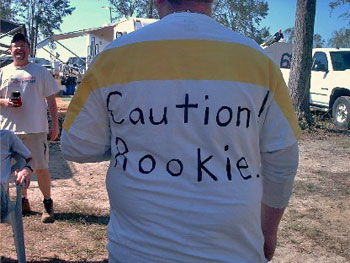There’s no polite way to say this so I’ll just be blunt. Too much business journalism is crap. It’s dull, reactive, inaccurate, misleading…did I say dull? Much of the problem can be traced to rookie mistakes. I made many of them myself when I was starting out and our branch of journalism was only beginning to be professionalized. Now, there’s less excuse.
Here are a few pet peeves that I see inflicted on readers almost every day, even in some large newspapers:
1. Jargon.
It’s one thing to lead a reader into knowledge about an industry. For example, reporting port traffic by explaining the yardstick measure “TEUs,” or twenty-foot equivalents, which is the cargo capacity of the standard shipping container. Or give colorful insider language, such as Goldman Sachs infamously referring to credulous clients as “muppets.” But too often journalists are captured by corporatese or sales language. At best it makes the story sound unsophisticated or cliched, at worst it misleads. A “gated community” is actually a gated property. What, exactly, is a “paradigm shift”? “Core competency”? “Bleeding edge”? Even shorthand with real meaning, such as “scalable” or “ecosystem” has quickly become hackneyed. “Innovation.” What does this buzzword mean?
2. Lack of context.
The regular PricewaterhouseCoopers report on venture capital for a state or metro is released, and the reporter dutifully takes dictation. At best, it is compared with the same period in the previous year. But more is needed in a competitive global economy. How did your state or metro compare with the national trend and, especially, with peer regions? Or, a company announces it will hire a number of new workers. Readers are usually left to guess some of the most basic things. Is this a lot of hiring (compared to the company’s current workforce)? Is it fulltime? What are the starting salaries? How has the firm’s total workforce fared over the past five years? If the company declines to give even the most basic information, write this —or reconsider covering it at all.
3. Failing to use the morgue.
Every person and company you write about should be run through the newspaper’s archive, as well as on a search engine such as Google or Bing. You’ll find the most amazing things, such as that the plucky small-business owner was convicted of larceny or filed for bankruptcy a decade ago. In addition, you need to know the history of the company: Layoffs, leveraged buyouts, products that failed or succeeded, competitors, etc. This is a simple step that is so often missed.
4. Using a single source.
I can think of few instances where this is good practice: A breaking story of a regulatory or court decision, an announcement of a major plant relocation or layoffs. Even then, this is good enough only for the early online story. Every fact and assertion needs corroboration. Independent voices give a story depth and oftentimes contradict or add shading to a sunny pronouncement from corporate flacks.
5. Failing to ask the follow-up questions.
The late Paul McClung, executive editor of the Lawton Constitutionin Oklahoma, brought reporters up short by asking, “Why is that?” And, if greeted by a half-answer, asking it again. It’s one of the best follow-up questions I know. Don’t be afraid to act dumb. Be Colombo, Peter Falk’s television detective who would ask all sorts of questions, some innocuous, many dumb, all cutting their way to the heart of the matter. Don’t let a piece of jargon go by without asking, “And what does that mean?” If you hear it in a conference call with analysts, go back and find a knowledgeable source who can explain it. End interviews by asking where you can reach the source if you have more questions.

6. The predetermined thesis.
These are often stories that come out of the morning news meeting and they always spell trouble. “(Unnamed Big Newspaper) reported that more veterans are being hired. Let’s go find some veterans that are being hired!” But this might not be happening in your city. Or there might be a better story: They are being hired into part-time, low-wage jobs. First, always advance a story you’re ripping off (“localizing”) with your own added value. More importantly, start with what I call a line of inquiry rather than a settled statement. For example, how are veterans faring in the local job market? You will usually be surprised by what you find, and that makes for a compelling, original story.
7. The placid feature.
These are valued because they’re easy, don’t provoke nasty emails from corporate communications and critical comments from the trolls, and you get to feel as if you’re a good person, “a member of the community” writing “good news.” That’s not your calling. It’s the mindset that helped America sleepwalk into the subprime crisis. What we do is hard and necessary. How many times as a business editor did I have to tell a P.R. person or chief executive, “We’re not your publicist and we’re not your cheerleaders. What we will be is accurate and fair, and as complete as time and space allow.” Even a feature worth pursuing should have conflict and stakes — and news. Our readers are busy and flooded by information. We won’t survive if our work is dull and placid.

8. The gullible small-business story.
This usually has all the elements listed above, but is applied to one of the most difficult beats to cover properly. Reporter goes out, interviews “entrepreneur,” assigns photo (and video!), writes it up, claims paycheck. At the least, this produces tedious, unimaginative journalism at a time when people are desperate for the economic upheavals all around them to be explained. It gives a preference to a business that is no different from a hundred others. At the worst, the reporter is taken in by a grifter who gets free publicity and no real scrutiny. Another time I will write about best-practices for covering small business. But be wary. Time and resources are scarce: Editors and reporters need to ask more often: Why is this news?
9. Failure to read.
Do you read the Wall Street Journal and New York Times every day? Do so, even if your bosses dismissively say, “We’re not trying to be them.” Along with Financial Times, they represent the best business reporting and writing in the English language. Don’t just read — crib. What sources did they use? What was their point of attack on a complex story? How did they write a compelling read? Also, read the business weekly, business blogs, magazines, SEC docs, economic reports. Read, read, read. And learn from it.
10. Laziness.
Get out of the newsroom. Pick up the phone. Don’t just live online. Get to know the players on your beat and every part of town. When I was a business editor, reporters who dutifully sat before their computers all day were soon on a performance improvement plan. Also, take time away to brainstorm, in longhand on a legal pad. It will do amazing things to get your brain out of the workaday mode and thinking about what really needs to be covered and how.
I know how the world works. Some corporate owners don’t want much of what they consider “bad news” or things that might upset the publisher’s friends. Editors are often tied down in meetings and scrambling to put together art and multimedia presentations, rather than coaching and, well, editing. Many news organizations, especially at the local level, don’t value business news. You can still practice guerrilla journalism. For example, that placid feature assigned to you can still have tension and sophistication. A well-worked beat can give you better story ideas to feed your editor before she gets sandbagged with a “localize this” at the morning meeting.
Our calling really matters. We need to rise to it every day, every story. It takes 10 years to make a really competent business reporter. So keep on learning. I certainly do.










